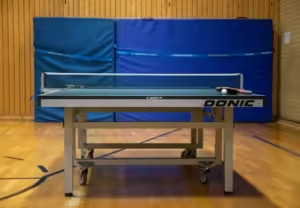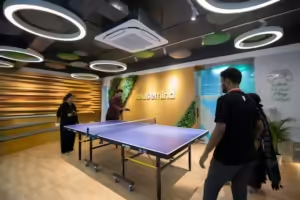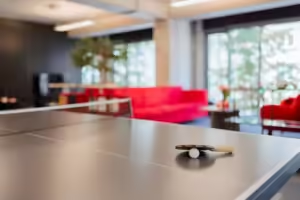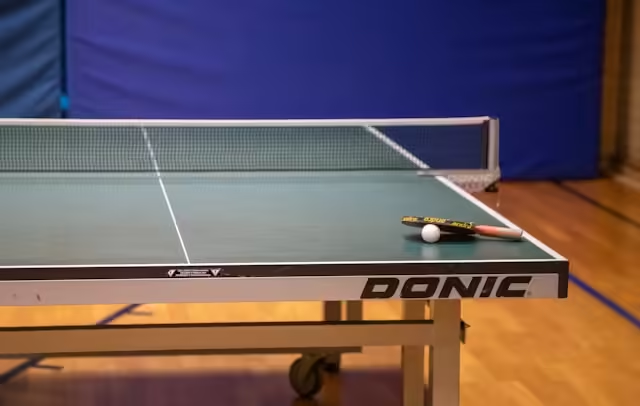One Player Table Tennis
Table tennis – while traditionally played with two or four players, is a sport known for its speed and strategic aspects of the game. But what do you do when you’re feeling in the mood to work it out, but are all alone? This is where one-player table tennis comes in. In my guide on refuge from the game ways and means I describe tools, techniques for how do you have to enjoy practice alone, ergo solo table tennis practice — And escape as someone who can help improve sit form without an eggs partner.
A) What is One-Player Table Tennis?
Single table tennis, or solo / self-practice table tennis for short, this is a way to train by yourself without the help of another person. While a lot of players think about the game in terms of rallies and ways to keep the ball low, solo hitting is where he came alive. It is especially beneficial in improving certain elements of your play, like accuracy, speed and hand-eye coordination.
Tools for Solo Practice:
While playing with an opponent is ideal for testing strategies and endurance, one-player table tennis focuses on technique refinement. You can achieve this using various tools, such as:
- Table tennis ball machines that shoot balls toward you at varying speeds and angles.
- Rebound boards or return nets, which simulate an opponent by sending the ball back to you after it hits the surface.
- Solo drills, where you practice serves or strokes against a wall or focus on ball control with a paddle and ball.
Playing alone allows you to target specific skills that are often harder to focus on during competitive matches. Plus, it provides flexibility—allowing you to practice anytime, regardless of whether a playing partner is available.
B) Key Benefits of One-Player Table Tennis
Practicing solo offers numerous advantages, helping players refine their skills and maintain their fitness levels. Here are some of the primary benefits of one-player table tennis:

Improved Reflexes
Solo practice, especially with a ball machine or rebound net, provides repetitive ball delivery, enabling you to sharpen your reflexes. By playing alone, you can react faster to different ball speeds, spins, and angles, which translates into quicker reflexes during a real match. Consistent practice also helps improve hand-eye coordination, making your movements more precise.
Enhanced Technique
During competition, we typically want to win and it may be difficult to focus on little details of a play. Solo practice allows you to focus purely on form and mechanics. You can break down your strokes and serves, correcting mistakes and perfecting your technique without the pressure of immediate competition.
Self-Discipline
Being the only one playing table tennis, it takes a little self-discipline. The good and the bad is you are on your own to stay focused since no one else can motivate or challenge samewise. Here, mental toughness – a result of drilling alone — can be transferred to matches where concentration is necessary for survival.
Flexibility in Practice
The biggest advantage associated with one-player table tennis is that it allows the player to practice whenever and in whatever way he wants. Now you don’t have to set-up practice times when the other person is available. Solo practice can fit in any schedule, whether you have 10 minutes or an hour.
C) Tools and Equipment for Solo Practice
The game of one-player table tennis will be best if you have the equipment requisite for it. Sure, you can even practice with just a paddle and ball but some tools will help making the training experience better / more effective.
Ping Pong Ball Machines
Ball machines are perhaps the most popular tool for solo practice. These machines can shoot table tennis balls at various speeds, spins, and directions, allowing you to practice different strokes and movements. Some machines allow you to program specific shot patterns, such as topspin, backspin, or side-spin, making it possible to replicate real-game situations.
Popular brands like Newgy Robo-Pong or iPong offer affordable, easy-to-use machines that can be set up in any space. By controlling the ball speed and spin, you can practice everything from defensive blocking to aggressive smashing.
Rebound Board or Net
Rebound boards and nets are similar to ball machines but can be a little easier to set up (though not as easy as the small coaching target) and they cost less. You put the Board at one end of a table, and you hit ball against it in return)=> It is an easy concept of practising the basic movements and also improving your counter striking.
Solo Drills
Even if you do not have a ball machine or rebound board, use solo drills to improve your practice. In this case you could try bouncing the ball on your paddle a number of times in succession to improve control, or serving at different areas of the table. These drills focus on building base strength with little in the way of equipment.
D) How to Set Up a One-Player Table Tennis Practice
Setting up a productive one-player table tennis session is easy, but it’s important to prepare your space and equipment correctly.

Choosing the Right Space
Step One: Clear a space for your playing area. If you are practicing indoors make sure the space is well lit and large enough to move freely. You can also practice outside, but you will have to cope with wind and what is on the ground.
Equipment Setup
If you’re using a ball machine, set it up at one end of the table, adjusting the speed and direction based on your practice goals. If you’re using a rebound net, place it securely on the table. Make sure to have enough table tennis balls at hand to avoid interruptions in your practice.
Safety Measures
Before starting, always warm up to avoid injuries. Stretching and light cardio exercises can help prepare your muscles for the quick, repetitive movements involved in table tennis. Also, ensure your equipment is securely set up to prevent accidents during practice.
E) Essential Techniques for One-Player Practice
Solo practice offers a unique opportunity to break down and improve individual techniques that might get overlooked in a competitive match.
Stroke Improvement
Use your solo time to focus on forehand and backhand strokes. Practice hitting the ball with different types of spin top-spin, back-spin, and side-spin while maintaining consistency. By again repeating these strokes, you’ll build muscle memory and improve your form.
Serving Practice
Of course the best way to get better is by serving, and you can do that on your own many times. Practice with serves of varying lengths or depths and spins, aiming at different parts of the table A single stroke without an opponent, as your only focus is precision.
Footwork Drills
Good footwork is also one of the most important things in table tennis and playing solo can give you chances to improve your leg work around the table. Different instructions on how to hit the ball from different angles and situation, quick feet movement drills.
Target Practice
One way to improve precision is by aiming at specific spots on the table. This can be done with a ball machine or through simple rebound drills. Mark targets on the table with tape or cones and practice hitting them consistently.
F) Mental Toughness and Focus in One-Player Table Tennis
Solo practice requires immense mental focus, and it can be easy to lose concentration without an opponent pushing you. Here’s how you can build mental toughness through solo play:
- Visualization Techniques: Imagine you’re playing against an opponent and visualize how you’d react to different shots.
- Mindfulness: Stay present during your practice sessions, focusing fully on each stroke and movement.
- Challenge Yourself: Set goals for each session to keep things interesting, like achieving a certain number of successful serves or perfecting a spin.

G) Real-World Applications of Solo Practice
Even professional players incorporate solo table tennis practice into their routines. Players like Ma Long and Timo Boll have been known to use ball machines and rebound nets for targeted drills. Their success serves as an inspiration for amateur players to take solo practice seriously.
By integrating solo practice into your routine, you’ll notice improvements in your competitive game. This all around solo practice experience will help you in developing more precision, control and reflexes that are directly transferable into better match performance.
H) Common Challenges and How to Overcome Them
Lack of Motivation
Solo practice is hard to stay motivated for. In order to combat this, create specific objectives for what you want to achieve in each session and monitor your progress across the sessions.
Repetitiveness
Solo practice can feel repetitive, so it’s essential to introduce variety into your drills. Change up the speed, spin, and angles of your shots, or set new challenges for yourself.
Technique Mastery
Without an opponent providing feedback, it can be tough to identify mistakes. Record your practice sessions to analyze your technique later or use tools like mirrors to observe your form.
I) Expert Tips for Effective Solo Table Tennis Practice
To make the most of your solo practice sessions, consider these expert tips:
- Stay Consistent: Regular practice is the key to improvement. Even short, focused sessions can lead to significant gains over time.
- Push Your Drills: — You should not practice this as exercise otherwise you will get nowhere instead start with advanced methods, higher spins and faster speeds to challenge yourself.
- Rest and Recover: Take breaks in between sessions to allow your body recovery time, especially for extended practice periods.
Conclusion
Playing ping pong by yourself is just really good at making you better, which means better reflexes and resilience. Even just hitting against a ball machine or bouncing the ball of a rebound net to work on your technique and footwork instead of doing nothing will make you play miles better than all those who sit themselves around waiting for others to do them favours. Accept solo practice as an important component of your rehearsal routine, and you will notice the results manifest in your competitive games.
Difference Table of the Content
| Section | Description |
|---|---|
| What is One-Player Table Tennis? | Solo or self-practice table tennis to improve technique without a partner; focuses on accuracy, speed, and hand-eye coordination. |
| Tools for Solo Practice | Tools include ball machines (for varied speeds and spins), rebound boards/nets (simulate opponent returns), and solo drills (e.g., serves against a wall). |
| Key Benefits | Improves reflexes, technique, self-discipline, and flexibility in practice times. Solo practice allows focus on specific skills often missed in competitive play. |
| Essential Equipment | Equipment includes ball machines (e.g., Newgy Robo-Pong, iPong), rebound boards, and basic gear (paddle, balls). Each tool provides different advantages for skill-building. |
| Setting Up Practice | Set up in a spacious, well-lit area with securely placed equipment. Use a ball machine or rebound net to maintain flow. Warm-up and practice safety measures are essential. |
| Techniques for Solo Practice | Focus on stroke improvement (forehand, backhand, spins), serving (precision and depth), footwork drills, and target practice (aiming at marked spots on the table). |
| Mental Toughness | Solo practice builds focus through visualization, mindfulness, and setting personal goals. Mental discipline transfers to competitive games. |
| Professional Applications | Even professional players (e.g., Ma Long, Timo Boll) use solo practice tools like ball machines and rebound nets for skill refinement, demonstrating the value of one-player practice. |
| Challenges & Solutions | Motivation and repetitiveness can be issues; overcome by setting goals, adding variety to drills, and analyzing recorded sessions to improve technique. |
| Expert Tips | Consistent practice, challenging drills, and taking recovery breaks enhance skill development and prevent burnout. |
| Conclusion | Solo practice enhances reflexes, technique, and mental toughness, becoming a valuable component in a player’s training routine, with results seen in competitive performance. |





One thought on “How to Practice One Player Table Tennis”